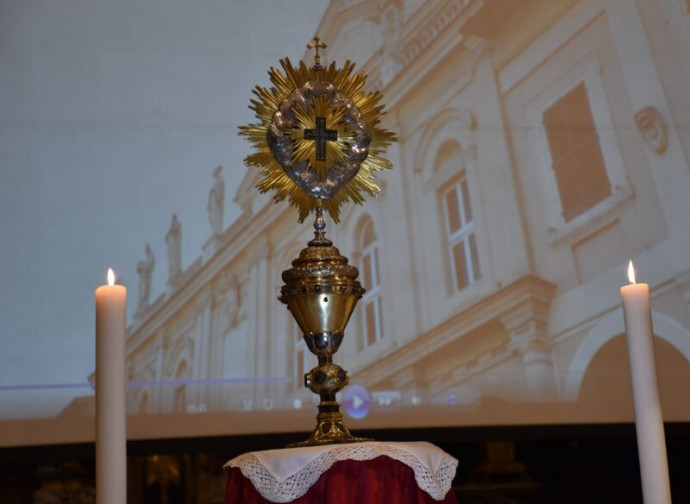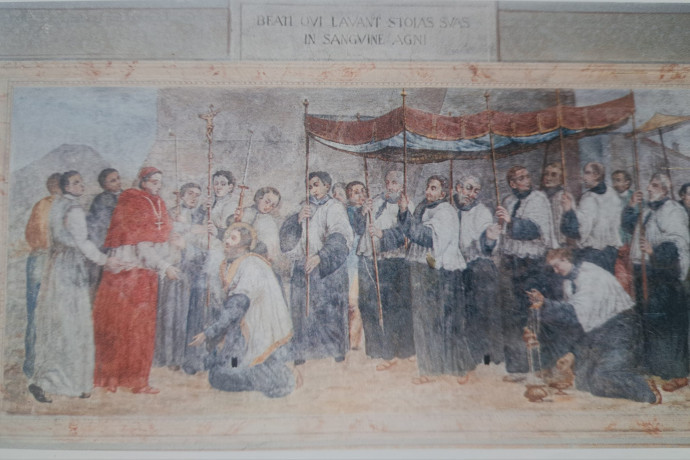Italian city revives veneration of Precious Blood of Jesus relic
Terni, a town in Italy’s most central region, is hosting celebrations for the feast of the relic of the Precious Blood, preserved in the cathedral. The link with Saint Joseph of Cupertino, who venerated the precious relic. And the city liberated from the plague. A glimpse of "a fundamental devotion".

Terni, a town in the landlocked region of Umbria in Italy, for two weeks this September, is holding a series of events in connection with the feast in honour of the Precious Blood of Jesus. The holy relic is kept in the town’s cathedral Santa Maria Assunta. Liturgically, the celebrations which began on September 9 will culminate on Sunday 22 September, in the Mass presided over by Bishop Francesco Antonio Soddu, who will bless the faithful with the relic. The relic is essentially "pectoral cross that in the transverse part bears a splinter of the True Cross of Christ and in the longitudinal part, in a small vial, a few drops of Jesus blood", explains Don Alessandro Rossini, parish priest of Terni Cathedral.
 The relic’s authenticity is historically attested, in good substance, by an episode involving a famous mystic: Saint Joseph of Cupertino (1603-1663). The patron of students was a close friend of Cardinal Francesco Angelo Rapaccioli (1605-1657), who held a special veneration for him. One day the cardinal went to Assisi to meet with Fra Giuseppe. The meeting took place near the Basilica of St. Francis, in front of a number of witnesses, who accompanied both the cardinal and the Friar Minor Conventual. As soon as the two friends faced each other, the saint from Cupertino, by divine inspiration, knelt in an act of adoration to the relic of the Precious Blood that the cardinal wore, hidden, beneath his robes. In memory of this encounter, there is an 18th-century painting [see detail in adjacent photo; below, the full painting], displayed on the left wall of the presbytery (looking at the tabernacle), opposite the organ, of Terni's cathedral.
The relic’s authenticity is historically attested, in good substance, by an episode involving a famous mystic: Saint Joseph of Cupertino (1603-1663). The patron of students was a close friend of Cardinal Francesco Angelo Rapaccioli (1605-1657), who held a special veneration for him. One day the cardinal went to Assisi to meet with Fra Giuseppe. The meeting took place near the Basilica of St. Francis, in front of a number of witnesses, who accompanied both the cardinal and the Friar Minor Conventual. As soon as the two friends faced each other, the saint from Cupertino, by divine inspiration, knelt in an act of adoration to the relic of the Precious Blood that the cardinal wore, hidden, beneath his robes. In memory of this encounter, there is an 18th-century painting [see detail in adjacent photo; below, the full painting], displayed on the left wall of the presbytery (looking at the tabernacle), opposite the organ, of Terni's cathedral.
Cardinal Rapaccioli was also, for 10 years, bishop of Terni (1646-1656) and in 1651 he wished to donate the precious relic of the Precious Blood to the Umbrian diocese.
Of particular historical importance is also another fact linked to this relic, which occurred under Rapaccioli's immediate successor serving at the head of the diocese: monsignor Sebastiano Gentili, bishop of Terni from May 1656 to August 1667. In 1656, the first alarming rumours of a plague epidemic had reached the city, which was affecting the Italian peninsula, particularly the centre-south. The civil authorities took a series of measures to prevent contagion: they placed armed militia at the gates of Terni to prevent people from infected cities entering the town, appointed a sanitary commission and established various restrictions, while promoting the celebration of expiatory services in the cathedral and other city churches.
Despite the cautionary measures, the plague also reached Terni, claiming many victims. The bishop, then, at the pleas of the people imploring divine assistance, carried the relic of the Blood of Jesus in procession and, from the heights of Torre Barbarasa, blessed Terni with the same relic, asking God to deliver the city from the plague. It was 21 June 1657. In memory of this ostension, a plaque in Latin remains, affixed to the Barbarasa Tower, which reads: "To Sebastiano Gentili, bishop of Terni, who, in order to put an end to the plague raging throughout the city, from this tower of Barbarasa, showed the afflicted citizens shut up in their homes the relics of the Blood of Christ, on 21 June 1657. Felice Barbarasa, as a sign of great and revered respect, placed, as a private individual, this plaque in memory of a public benefit". In the following months, especially from August, the cases of plague decreased and gradually disappeared.
This event, is one that represents a cross-section of the faith in God's intervention in history like those that have characterised many municipalities in Italy and that with modernity is progressively being lost, even within the Church. Supernatural interventions that are certainly not the ‘fantasies’ of the faithful, but which are reflected in sacred art, inscriptions, ancient buildings, as the events of this relic of the Precious Blood remind us.
In recent years, the diocese of Terni is re-proposing this historical devotion, as Don Rossini explains. This feast, celebrated in recent times with greater solemnity, is intended to be "an image of the rebirth of the city - says the priest - and, in its broadest sense, of the fight against the moral plague: a sign of hope for everyone, starting with the younger generations, transmitting to them the truth that salvation comes from the Blood of Christ".
Even St. Gaspar del Bufalo (1786-1837), the great apostle of the Precious Blood, stressed the need to propagate this devotion, as old as Christianity. "I wish I had a thousand tongues - he wrote - to soften every heart towards the Precious Blood of Jesus. This is a fundamental devotion that embraces all others: it is the basis, the support, the essence of Catholic piety. Devotion to the Precious Blood, that is the weapon of our times!". In fact, it was a disciple of St. Gaspar, the venerable (soon to be blessed) Don Giovanni Merlini, who obtained from Blessed Pius IX, in 1849, that the feast of the Precious Blood be extended to the whole Church. St Pius X setting the date at 1 July. Following the liturgical reform of 1969, the celebration proper to 1 July was suppressed and it was decided to celebrate the Precious Blood together with Corpus Christi. The solemnity of 1 July, however, survives in the institutes dedicated to the Precious Blood and in the extraordinary form of the Roman Rite.
Then of course there are the local feasts, with different dates. Other cities, in Italy and abroad, boast the custody of drops of the Blood of Christ, which is evidently the most precious relic of all, since it is the price Our Lord paid for our redemption. The best known case, in Italy, is that of Mantua, where Saint Longinus, the Roman soldier (whose original name was Cassius, according to the revelations received by the Blessed Anna Catherine Emmerick and transcribed, with some licence, by Clemens Brentano) who pierced Jesus' side with a lance, causing blood and water to spill out, is said to have been martyred. According to the well-established Mantuan tradition, Longinus is said to have collected earth soaked in the Blood of Jesus on Calvary, the cause of his own conversion. He then travelled to Italy, bringing with him the precious relic, which is today preserved in the Basilica of Sant'Andrea, in Mantua.

Saint Valentine, when love is tinged with martyrdom
February 14 is universally known as Valentine’s Day, a celebration day for lovers. At the origin of an anniversary that is now mainly commercial lies the extraordinary story of a saint who was martyred for blessing the marriage of a Roman legionnaire who had converted to marry a young Christian.


